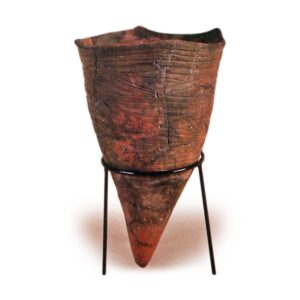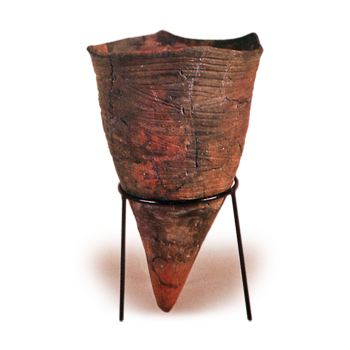
Earthenware with a pointed bottom. It generally has a simple deep-bottomed shape with a straight mouth, and there are various forms such as V-shaped longitudinally, with the apex protruding, U-shaped with a rather rounded bottom, and with the apex protruding like a papillae after being constricted near the apex of a cannonball-shaped vessel. Most of the pointed-bottomed earthenware from cultures based on hunting and fishing was of a simple deep-bottomed form, and in many cases there was only one type of earthenware, without other types. They are mainly used for boiling. Examples include the pointed-bottom Jomon pottery of Japan, Neolithic comb pottery of Korea, Neolithic comb pottery of Northern Eurasia, and Eltebele culture pottery of the Middle Stone Age of Northern Europe. On the other hand, most of the earthenware that was established in agricultural societies was refined or coarsely made from the beginning, and consisted of several types of flat-bottomed earthenware. Sometimes the coarse earthenware includes pointed-bottomed vessels. In this case, the forms are not always simple, nor are they necessarily for boiling. Examples can be found in Chinese Neolithic (Shao-Culture), the Indus Civilization of Pakistan, and the Bronze Age of Egypt. In Japan, Jomon pottery began as pointed-bottomed earthenware, and until recently it has been understood that it replaced flat-bottomed earthenware at the end of the early period or in the first half of the early period in some areas. However, it is now clear that flat-bottomed earthenware existed in the first half of the Early Jomon period prior to the appearance of pointed-bottomed earthenware. Some interpretations of the form of pointed-bottom earthenware suggest that it was formed as a result of ingenuity to make it convenient for boiling and cooking. There are examples of pointed-bottomed earthenware excavated at early sites in the southern Kanto region, which were pierced by a furnace in which stone blocks were collected. There is also a theory that the reason for the pointed bottom was to imitate the shape of baskets in Europe. Another interpretation is that pointed-bottomed earthenware was more practical because European dwellings were uneven and soft, whereas Neolithic dwellings in the Middle East had hard and smooth clay floors.



